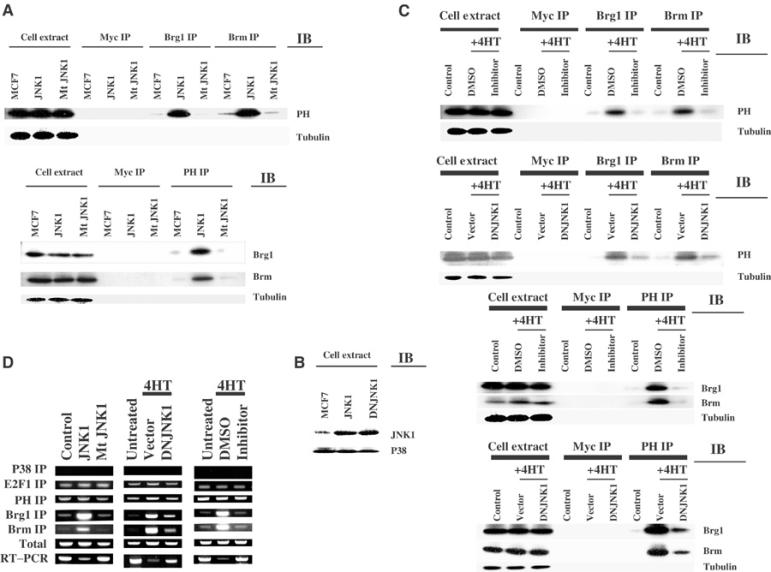Figure 7.

JNK1 mediates estrogen antagonist signaling to the prohibitin/E2F axis. (A) MCF7 cells were transfected with JNK1 or mutant (kinase-deficient) JNK1. Immunoprecipitation/immunoblot analysis (IP/IB), and the reciprocal IP–IB, was performed using the indicated antibodies. Anti-Myc and -tubulin antibodies were used as controls for IP and IB. Equal loading and precipitation are further confirmed by immunoblotting using antibodies for the target proteins (data not shown). JNK1 overexpression induced association between prohibitin and Brg1/Brm, just as tamoxifen does (see Figure 1). (B) The same cell extracts used in panel A were analyzed by immunoblotting using anti-JNK1 antibody or -p38 antibody, confirming the overexpression of the products of the transfected vectors. (C) JNK1 activity was suppressed either by transfection of DNJNK1 or treatment with a JNK1 inhibitor. The cells were co-treated with tamoxifen (‘4HT') or vehicle controls as indicated for 3 h. DMSO was vehicle control for JNK1 inhibitor. Empty vector (‘vector') was transfected as a control for the DNJNK1 vector. Immunoprecipitation/immunoblot analysis (IP/IB), and the reciprocal IP/IB, was performed using the indicated antibodies. Equal loading and precipitation are further confirmed by immunoblotting using antibodies for the target proteins (data not shown). DNJNK1 and JNK1 inhibitor each blocked the enhanced association between prohibitin and Brg1/Brm induced by tamoxifen. (D) In vivo CHIP assay. Left column: MCF7 cells were transfected with empty vector control, JNK1, or mutant (kinase-deficient) JNK1 vectors. Cell extracts were analyzed using an in vivo CHIP assay on the endogenous, native E2F1 promoter, described in Figure 3 (above). Higher levels of amplified products precipitated by the Brg1 or Brm antibodies were detected when JNK1 (but not mutant JNK1) was transfected. This enhanced recruitment of Brm and Brg1 by JNK1 was similar to that induced by tamoxifen treatment, as shown in Figure 3. RT–PCR assays demonstrated a relative decrease in the levels of transcripts from the E2F1 genes when JNK1, but not the mutant JNK1, was transfected. Middle column: MCF7 cells were transfected with control vector or DNJNK1. Cells were treated with ethanol vehicle or tamoxifen as indicated. CHIP assay was performed on the native E2F1 promoter. Transfection of the DNJNK1 blocked the tamoxifen-induced recruitment of BRG1 and BRM to the E2F1 promoter, and reversed the repression of E2F1 transcript levels. Right column: MCF7 cells were treated with ethanol (for tamoxifen vehicle control), DMSO (for JNK1 inhibitor vehicle control), or JNK1 inhibitor. Cells were collected after 3 h of treatment. Extracts were analyzed by CHIP assay. Similar to the effects of DNJNK1 shown in the middle panel, the JNK1 inhibitor also blocked the tamoxifen-induced Brg1/Brm recruitment to the native E2F1 promoter, and the tamoxifen-induced repression of E2F1 transcript levels was reversed by the inhibitor.
